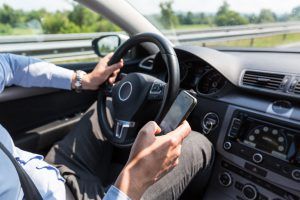Just. Stop. Now.

You’ve read the stories. You’ve seen them on Facebook and various news sites and stations. You’ve watched the commercials and seen the videos posted to social media. All of them have one message—avoid distracted driving at all costs. Now, if you think you’ve had enough of that subject, feel free to skip down to the last paragraph because that’s the part I really want you to remember. But if you have the patience of Job and a love of statistics, you may continue to your destination via the scenic route.
Recently Kyle Stock, Lance Lambert, and David Ingold published a lengthy article on the subject that was picked up by several websites—an article filled with all manner and kind of statistical evidence in support of technological abstinence when behind the wheel. For example, road fatalities, which had been declining for over 20 years, suddenly jumped by 14.4 percent over the last two years, while smart phone usage increased from 75 percent to 81 percent over the same time period. Coincidence? Probably not. And what about the nature of these deaths? The increased number of victims is often made up of bicyclists, motorcyclists, and pedestrians—people who more easily become invisible when your eyes leave the road and focus on a phone. Pedestrian deaths alone increased 22 percent in the last two years—and honestly, those deaths could just as easily be attributed to distracted walking as distracted driving.
Sadly, the statistical evidence available (only a very small portion of which has been mentioned here) is most certainly much lower on paper than in reality. The use of the technology has far outpaced the ability to analyze and record that usage and its consequences. Although actually speaking on a cell phone, even hands-free, is dangerous, most Americans have abandoned talking for texting, tweeting, and over-sharing on Facebook and Instagram. Seventy percent of the driving population was engaging in that behavior in 2015. Two years later that percentage had jumped to 80. Zendrive, Inc., a company that analyzes smartphone usage for commercial insurers, found that, out of three million drivers, 88 percent used their cell phone while driving. Do the math, folks. That’s 2,640,000 people on the road that aren’t completely focused on the 4,000 pound machine they’re supposed to be controlling or anything that happens into its path. And that didn’t count the phones that were in a fixed position for hands-free usage.
The statistical evidence in favor of avoidance is abundant, but unfortunately, the people who are guilty don’t seem to care, or they don’t believe it will ever happen to them. There are various technologies that can stop smartphone usage while driving, but the use of those technologies is voluntary in nature, and again, the people who are guilty aren’t going to voluntarily surrender access to their hand-held cellular device. Until we begin to see distracted driving through the same lens as driving under the influence, the deaths will continue to mount. And no volume of statistical evidence is going to put a dent in that. It’s going to take concentrated effort on the parts of automobile manufacturers, smartphone providers, and lawmakers to halt the carnage.
So, here’s the part I want you to remember. Here’s the take-away from today’s message and it comes from someone who has seen the devastated families mourning the unnecessary loss of life:
You are not immortal. You are not invincible. At some point, you will die, and that should be later rather than sooner. There is no text message or shared moment that is worth your life or, heaven forbid, the life of the innocent person you kill. Just. Stop. Now.
The post Just. Stop. Now. appeared first on Shackelford Funeral Directors | Blog.
365 Days of Grief Support
Sign up for one year of grief messages designed to offer hope and healing during the difficult first year after a loss
A Year of Grief Support
Sign up for one year of weekly grief messages designed to provide strength and comfort during this challenging time.
Please wait
Verifying your email address
Please wait
Unsubscribing your email address
You have been unsubscribed
You will no longer receive messages from our email mailing list.
You have been subscribed
Your email address has successfully been added to our mailing list.
Something went wrong
There was an error verifying your email address. Please try again later, or re-subscribe.












